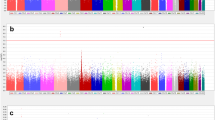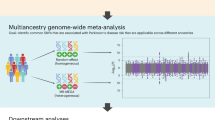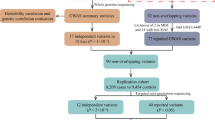Abstract
The PARK16 locus, spanning five genes on chromosome 1, was among the first genetic regions to show genome-wide association in Parkinson's disease (PD). Subsequent investigations have found variability in PARK16 top-hits and association patterns across populations, and the implicated genes and mechanisms are currently unclear. In the present study, we aimed to explore the contribution of PARK16 variability to PD risk in a Scandinavian population. We genotyped 17 single-nucleotide polymorphisms in a case-control sample set of 2570 individuals from Norway and Sweden to fine map the locus. Targeted resequencing of the full coding regions of SLC45A3, NUCKS1, RAB7L1, SLC41A1 and PM20D1 was performed in DNA pools from a subset of 387 patient samples. We find evidence for an association with PD for rs1775143 as well as a haplotype located around the 5′ region of RAB7L1, implicating variants which are not in high linkage disequilibrium with the strongest signal from a recent large meta-analysis in Caucasians. We also provide suggestive support for epistasis between RAB7L1 and LRRK2 as previously hypothesized by others. Comparing our results with previous work, allelic heterogeneity at PARK16 appears likely, and further studies are warranted to disentangle the complex patterns of association and pinpoint the functionally relevant variants.
Similar content being viewed by others
Log in or create a free account to read this content
Gain free access to this article, as well as selected content from this journal and more on nature.com
or
References
Satake, W., Nakabayashi, Y., Mizuta, I., Hirota, Y., Ito, C. & Kubo, M. et al. Genome-wide association study identifies common variants at four loci as genetic risk factors for Parkinson's disease. Nat. Genet. 41, 1303–1307 (2009).
Simon-Sanchez, J., Schulte, C., Bras, J. M., Sharma, M., Gibbs, J. R. & Berg, D. et al. Genome-wide association study reveals genetic risk underlying Parkinson's disease. Nat. Genet. 41, 1308–1312 (2009).
Hamza, T. H., Zabetian, C. P., Tenesa, A., Laederach, A., Montimurro, J. & Yearout, D. et al. Common genetic variation in the HLA region is associated with late-onset sporadic Parkinson's disease. Nat. Genet. 42, 781–785 (2010).
Edwards, T. L., Scott, W. K., Almonte, C., Burt, A., Powell, E. H. & Beecham, G. W. et al. Genome-wide association study confirms SNPs in SNCA and the MAPT region as common risk factors for Parkinson disease. Ann. Hum. Genet. 74, 97–109 (2010).
Spencer, C. C., Plagnol, V., Strange, A., Gardner, M., Paisan-Ruiz, C. & Band, G. et al. Dissection of the genetics of Parkinson's disease identifies an additional association 5′ of SNCA and multiple associated haplotypes at 17q21. Hum. Mol. Genet. 20, 345–353 (2011).
Saad, M., Lesage, S., Saint-Pierre, A., Corvol, J. C., Zelenika, D. & Lambert, J. C. et al. Genome-wide association study confirms BST1 and suggests a locus on 12q24 as the risk loci for Parkinson's disease in the European population. Hum. Mol. Genet. 20, 615–627 (2011).
Do, C. B., Tung, J. Y., Dorfman, E., Kiefer, A. K., Drabant, E. M. & Francke, U. et al. Web-based genome-wide association study identifies two novel loci and a substantial genetic component for Parkinson's disease. PLoS Genet. 7, e1002141 (2011).
Nalls, M. A., Plagnol, V., Hernandez, D. G., Sharma, M., Sheerin, U. M. & Saad, M. et al. Imputation of sequence variants for identification of genetic risks for Parkinson's disease: a meta-analysis of genome-wide association studies. Lancet 377, 641–649 (2011).
International Parkinson's Disease Genomics Consortium (IPDGC), Wellcome Truste Case Control Consortium 2 (WTCCC2) A two-stage meta-analysis identifies several new loci for Parkinson's disease. PLoS Genet. 7, e1002142 (2011).
Pankratz, N., Beecham, G. W., DeStefano, A. L., Dawson, T. M., Doheny, K. F. & Factor, S. A. et al. Meta-analysis of Parkinson's disease: identification of a novel locus, RIT2. Ann. Neurol. 71, 370–384 (2012).
Lill, C. M., Roehr, J. T., McQueen, M. B., Kavvoura, F. K., Bagade, S. & Schjeide, B. M. et al. Comprehensive research synopsis and systematic meta-analyses in Parkinson's disease genetics: the PDGene database. PLoS Genet. 8, e1002548 (2012).
Nalls, M. A., Pankratz, N., Lill, C. M., Do, C. B., Hernandez, D. G. & Saad, M. et al. Large-scale meta-analysis of genome-wide association data identifies six new risk loci for Parkinson's disease. Nat. Genet. 46, 989–993 (2014).
Mata, I. F., Yearout, D., Alvarez, V., Coto, E., de Mena, L. & Ribacoba, R. et al. Replication of MAPT and SNCA, but not PARK16-18, as susceptibility genes for Parkinson's disease. Mov. Disord. 26, 819–823 (2011).
Tucci, A., Nalls, M. A., Houlden, H., Revesz, T., Singleton, A. B. & Wood, N. W. et al. Genetic variability at the PARK16 locus. Eur. J. Hum. Genet. 18, 1356–1359 (2010).
Yan, Y., Tian, J., Mo, X., Zhao, G., Yin, X. & Pu, J. et al. Genetic variants in the RAB7L1 and SLC41A1 genes of the PARK16 locus in Chinese Parkinson's disease patients. Int. J. Neurosci. 121, 632–636 (2011).
Kolisek, M., Sponder, G., Mastrototaro, L., Smorodchenko, A., Launay, P. & Vormann, J. et al. Substitution p.A350V in Na(+)/Mg(2)(+) exchanger SLC41A1, potentially associated with Parkinson's disease, is a gain-of-function mutation. PLoS One 8, e71096 (2013).
MacLeod, D. A., Rhinn, H., Kuwahara, T., Zolin, A., Di Paolo, G. & McCabe, B. D. et al. RAB7L1 interacts with LRRK2 to modify intraneuronal protein sorting and Parkinson's disease risk. Neuron 77, 425–439 (2013).
Pihlstrom, L., Axelsson, G., Bjornara, K. A., Dizdar, N., Fardell, C. & Forsgren, L. et al. Supportive evidence for 11 loci from genome-wide association studies in Parkinson's disease. Neurobiol. Aging 34, 1708e1707-1713 (2013).
Pihlstrom, L., Rengmark, A., Bjornara, K. A. & Toft, M. Effective variant detection by targeted deep sequencing of DNA pools: an example from Parkinson's disease. Ann. Hum. Genet. 78, 243–252 (2014).
Tan, E. K., Kwok, H. H., Tan, L. C., Zhao, W. T., Prakash, K. M. & Au, W. L. et al. Analysis of GWAS-linked loci in Parkinson disease reaffirms PARK16 as a susceptibility locus. Neurology 75, 508–512 (2010).
Vilarino-Guell, C., Ross, O. A., Aasly, J. O., White, L. R., Rajput, A. & Rajput, A. H. et al. An independent replication of PARK16 in Asian samples. Neurology 75, 2248–2249 (2010).
Ramirez, A., Ziegler, A., Winkler, S., Kottwitz, J., Giesen, R. & Diaz-Grez, F. et al. Association of Parkinson disease to PARK16 in a Chilean sample. Parkinsonism Relat. Disord. 17, 70–71 (2011).
Chang, X. L., Mao, X. Y., Li, H. H., Zhang, J. H., Li, N. N. & Burgunder, J. M. et al. Association of GWAS loci with PD in China. Am. J. Med. Genet. B Neuropsychiatr. Genet. 156B, 334–339 (2011).
Yan, Y. P., Mo, X. Y., Tian, J., Zhao, G. H., Yin, X. Z. & Jin, F. Y. et al. An association between the PARK16 locus and Parkinson's disease in a cohort from eastern China. Parkinsonism Relat. Disord. 17, 737–739 (2011).
Wang, C., Cai, Y., Zheng, Z., Tang, B. S., Xu, Y. & Wang, T. et al. Penetrance of LRRK2 G2385R and R1628P is modified by common PD-associated genetic variants. Parkinsonism Relat. Disord. 18, 958–963 (2012).
Zhou, L. L., Zhang, X., Bao, Q. Q., Liu, R. P., Gong, M. Y. & Mao, G. Y. et al. Association analysis of PARK16-18 variants and Parkinson's disease in a Chinese population. J. Clin. Neurosci. 21, 1029–1032 (2014).
Soto-Ortolaza, A. I., Heckman, M. G., Labbe, C., Serie, D. J., Puschmann, A. & Rayaprolu, S. et al. GWAS risk factors in Parkinson's disease: LRRK2 coding variation and genetic interaction with PARK16. Am. J. Neurodegener. Dis. 2, 287–299 (2013).
Gan-Or, Z., Bar-Shira, A., Dahary, D., Mirelman, A., Kedmi, M. & Gurevich, T. et al. Association of sequence alterations in the putative promoter of RAB7L1 with a reduced parkinson disease risk. Arch. Neurol. 69, 105–110 (2012).
Raj, T., Rothamel, K., Mostafavi, S., Ye, C., Lee, M. N. & Replogle, J. M. et al. Polarization of the effects of autoimmune and neurodegenerative risk alleles in leukocytes. Science 344, 519–523 (2014).
Ramasamy, A., Trabzuni, D., Guelfi, S., Varghese, V., Smith, C. & Walker, R. et al. Genetic variability in the regulation of gene expression in ten regions of the human brain. Nat. Neurosci. 17, 1418–1428 (2014).
Acknowledgements
We thank all study participants. L. Pihlstrøm is supported by a grant from Health Region South-East, Norway. MT and AR are supported by grants from the Research Council of Norway. The study received funding from The Norwegian Parkinson Association Research Fund, Reberg’s Legacy, The Swedish Medical Research Council, The Swedish Parkinson Foundation, The Swedish Parkinson's Disease Association, King Gustaf V’s and Queen Victoria’s Freemason foundation and Swedish Brain Power. The sequencing service was provided by the Norwegian Sequencing Centre (www.sequencing.uio.no), a national technology platform hosted by the University of Oslo and supported by the “Functional Genomics” and “Infrastructure” programs of the Research Council of Norway and the Southeastern Regional Health Authorities.
Web Resources
The URLs for databases and software referenced in this article are as follows: 1000 Genomes, www.1000genomes.org. NHLBI Exome Sequencing Project (ESP), evs.gs.washington.edu/EVS/Burrows-Wheeler Aligner, bio-bwa.sourceforge.net. The Genome Analysis Toolkit, www.broadinstitute.org/gatk/. ANNOVAR, www.openbioinformatics.org/annovar/. SNAP, www.broadinstitute.org/mpg/snap/. Haploview, www.broadinstitute.org/scientific-community/science/programs/medical-and-population-genetics/haploview/haploview. PLINK, http://pngu.mgh.harvard.edu/~purcell/plink/.
Author information
Authors and Affiliations
Corresponding author
Ethics declarations
Competing interests
The authors declare no conflict of interest.
Additional information
Supplementary Information accompanies the paper on Journal of Human Genetics website
Supplementary information
Rights and permissions
About this article
Cite this article
Pihlstrøm, L., Rengmark, A., Bjørnarå, K. et al. Fine mapping and resequencing of the PARK16 locus in Parkinson’s disease. J Hum Genet 60, 357–362 (2015). https://doi.org/10.1038/jhg.2015.34
Received:
Revised:
Accepted:
Published:
Issue date:
DOI: https://doi.org/10.1038/jhg.2015.34
This article is cited by
-
Mendelian Randomization Analysis Identified Potential Genes Pleiotropically Associated with Polycystic Ovary Syndrome
Reproductive Sciences (2022)
-
Comprehensive analysis of PM20D1 QTL in Alzheimer’s disease
Clinical Epigenetics (2020)
-
Parkinson’s Disease is Associated with Dysregulations of a Dopamine-Modulated Gene Network Relevant to Sleep and Affective Neurobehaviors in the Striatum
Scientific Reports (2019)
-
Using KASP technique to screen LRRK2 G2019S mutation in a large Tunisian cohort
BMC Medical Genetics (2017)
-
LRRK2 and RAB7L1 coordinately regulate axonal morphology and lysosome integrity in diverse cellular contexts
Scientific Reports (2016)



